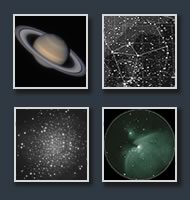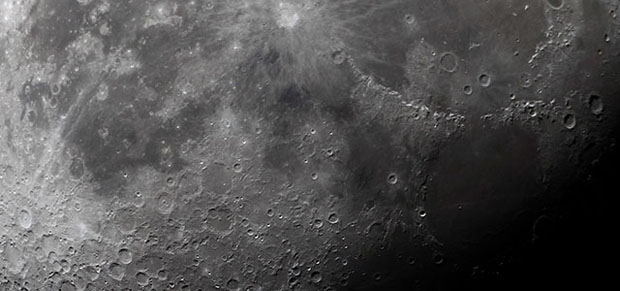What Can You See With Different Telescopes
Introduction
When someone considers buying a new telescope - the first question will usually be "what can I see through it?" In this article I will try to illustrate the views you can expect through different instruments, and perhaps help to decide which one to choose. The subjects covered here are: Moon, Planets, Sun, DSO, Comets, Stars, Light pollution.
The amount of observable celestial objects and their details will depend on several factors: The size and the optical quality of a telescope, sky darkness, atmospheric conditions, the observer's eyesight and experience. Let's start with the instrument.
Types of Telescopes
A telescope's optical tube has two important parameters: "aperture" and "optical quality". Aperture is the diameter of the objective lens or a mirror - it defines how much light the telescope gathers and its maximum resolving power. Optical quality is a general therm which describes the ability of a telescope to transmit unaltered image.
In this article there are 3 telescope categories, which will be referred by [orange] tags:
- [1] - Small and cheap (price range 50-200$). For example a 80mm reflector or a 70mm refractor, with mediocre optical quality (i.e: 1, 2, 3).
- [2] - Medium (price range 250-500$). For example a 150mm Newtonian reflector, a 130mm a Maksutov Cassegrain, or (for planets) a 100mm refractor (i.e: 1, 2, 3).
- [3] - Large (price range over 600$). For example a 250mm Newtonian reflector, a 250mm Schmidt Cassegrain, or (for planets) a 120mm refractor (i.e: 1, 2).
The prices are referring to the cheapest options of the specified apertures. By "large" I'm refering to telescopes up to 12" aperture (obviously there are larger amateur instruments, which won't be covered here).
For observing different types of objects there are different optical requirements. For Moon, planets, double stars and Sun it is better to have a small but quality 80mm refractor rather than a large 150mm reflector with poor optics. For deep sky objects the opposite is true - a cheap 200mm dobsonian reflector will usually outperform a top notch 80mm refractor.
The following sections will illustrate how various objects appear in different telescopes to a visual observer. Based on observing experience - I have used some real photos and processed sketches in order to simulate these views. While these images may illustrate the level of detail you can expect to see, they do not accurately show the perceived brightness.
The Moon
Our Moon is the easiest and the most impressive observing target. At low magnifications it will look approximately the same through any telescope. But a larger, more quality instrument will allow you to "zoom in", and reveal countless craters, rills and mountains.
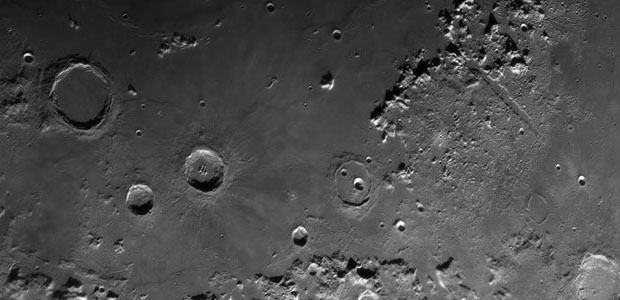
Moon through a large, quality telescope at high power (350x) [3]
The Planets
There are 8 planets in our solar system you can observe, however only three of them will show notable surface details: Jupiter, Saturn and Mars (mostly during opposition). Also these three planets will display time varying weather related phenomena - such as clouds and dust storms on mars or cloud bands on Jupiter. Jupiter also has easily observable 4 Jovian moons which rotate around it, occasionally transiting and casting a shadow over the planet's disk. There are several visible moons around the Saturn as well. In a moderate telescope Venus and Mercury will reveal their phases (a crescent shape) and Venus can even show hints of cloud details with a right filter. Neptune and Uranus will look like small, featureless, bluish or greenish disks through any telescope. The Pluto is very hard to observe visually, especially now - when it's in the milky way area, and even if you succeed it will look like a featureless faint star.
The following images show comparison of how Jupiter and Saturn should look in different instruments, at their highest useful magnifications:

Jupiter through a small, cheap telescope (100x power) [1]

Jupiter through a medium telescope (180x power) [2]
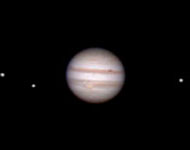
Jupiter through a large, quality telescope (300x power) [3]
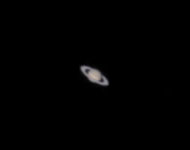
Saturn in a small, cheap telescope (100x power) [1]
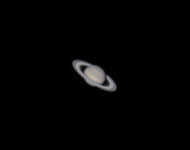
Saturn in a medium telescope (180x power) [2]
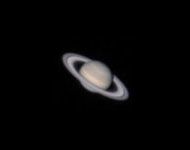
Saturn in a large, quality telescope (300x power) [3]
In order to see fine planetary details - the telescope, apart from quality optics and sufficient aperture - must be properly collimated and, in case of larger apertures, properly cooled. Apart from the telescope, the factor which greatly affects the observable planetary details is so called "seeing". It is the amount of atmospheric turbulence which causes the image to "dance" and become blurry (it is also the phenomenon which causes stars to twinkle). The images above show how the planets look during a moderate seeing. Under better conditions an experienced observer with a quality, properly collimated and cooled instrument might be able to resolve more surface details. And the opposite is true - the image can be much worse if a telescope isn't properly collimated, cooled or the seeing conditions are poor.
These illustrations simulate the visible detail rather than the actual field of view. As you can see in the following example - the planetary discs look really small through an eyepiece.

An example of how the jupiter looks in a medium telescope's whole field of view at 180x
Deep Sky Objects
Deep sky objects (DSO) is a general name for galaxies, nebulae and star clusters - objects beyond our solar system. Unlike with planets - observing deep sky objects does not necessarily require using high magnifications. What important is the aperture of your telescope, since you need to gather a lot of light. Another factor affecting our ability to observe DSO is sky darkness, and it is even more important than aperture. If you observe in the middle of a big, light polluted city - even owning a huge, 100000$ telescope won't help.
The following sketches simulate the level of details you can expect to see in some of the brightest deep sky objects, through telescopes with different apertures, under truly dark skies (and by "dark" I mean a place where you can see the Milky Way bright and detailed):
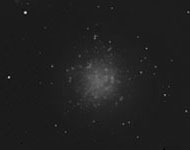
Hercules Cluster in a small telescope (dark skies) [1]

Hercules Cluster in a medium telescope (dark skies) [2]
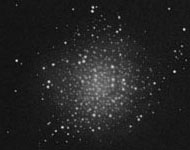
Hercules Cluster in a large telescope (dark skies) [3]

Pinwheel Galaxy in a small telescope (dark skies) [1]
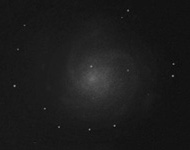
Pinwheel Galaxy in a medium telescope (dark skies) [2]
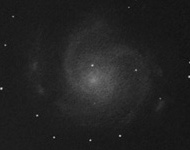
Pinwheel Galaxy in a large telescope (dark skies) [3]
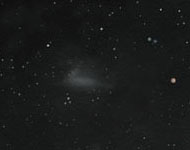
Swan Nebula in a small telescope (dark skies) [1]
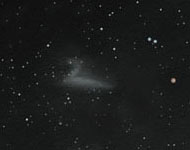
Swan Nebula in a medium telescope (dark skies) [2]
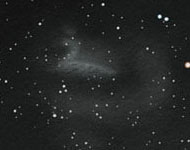
Swan Nebula in a large telescope (dark skies) [3]
There are only several dozens of deep sky objects which will show this amount of detail. The vast majority of visible DSOs will look much fainter. The following images show some more examples of deep sky objects which you may observe (there are hundreds of such objects) as they would look in a moderate telescope:
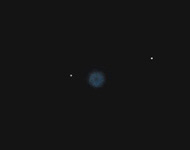
NGC 7662 planetary nebula in a moderate telescope [2,3]
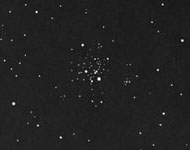
Messier 26 open cluster in a moderate telescope [2,3]
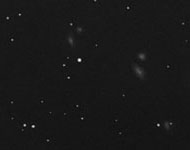
Virgo cluster of galaxies in a large telescope [3]
Note that these illustrations show what an experienced observer should see. Most of the deep sky objects are really faint and a beginner will have a hard time trying to see fine details or resolve the faintest objects. Also DSO will usually show no color (not even close to what we see in photos). The only colorful ones are brightest stars in some open clusters and several planetary nebulae. For more examples visit a gallery in "sketches of deep sky" section.
Effects of Light Pollution
As was mentioned above - the observing location is critical for observing deep sky objects. Under truly dark skies, where the milky way is bright, highly structured and you can barely resolve the constellations due to the sheer number of stars, a large 250mm telescope will show you 5-7 thousands deep sky objects, with hundreds of them showing a fair amounts of details (as in previous illustrations).
If you observe in the countryside or dark suburbs, where you can barely see the Milky Way, the number of deep sky objects you will be able to see is much smaller (1-2 thousands). Also you will be able to see less detail in them.
Living in a light polluted urban area does not mean you can't observe the deep sky. However keep in mind that only a handful can be seen and details of them will be far less impressive.
The following images illustrate the effects of light pollution on some of the brightest deep sky objects, which are observed using the same telescope from different locations. In this particular example - The Great Andromeda galaxy through a large telescope [3]:
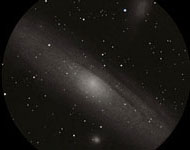
Under truly dark skies
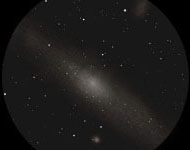
Countryside-suburbs area
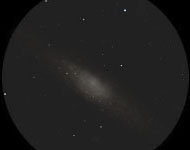
Light polluted small city
Effects of light pollution on fainter DSO such as distant galaxies will be even more dramatic. See an example of how some members of a Virgo galaxy cluster should look through a large telescope in different locations. As you can see - many fainter galaxies become invisible in areas with stronger light pollution:
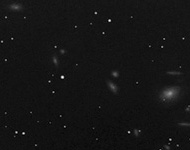
Under truly dark skies
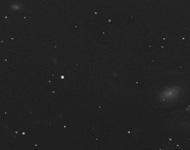
Countryside-suburbs area
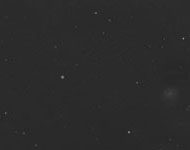
Light polluted small city
If you plan to observe deep sky objects from an area with a moderate light pollution - it is best to concentrate on objects like open clusters, double stars, brightest of the emission nebulae and also some bright planetary nebulae (due to their high surface brightness).
Stars and Double Stars
Even through the largest telescopes - stars appear like small dots of light (though they will look brighter, with enhanced colours). However any details you might think you are resolving are due to optical issues such as aberrations, eyesight, focus and atmosphere.
A telescope dramatically increases the number of observable stars. While with a naked eye you can see roughly 10,000 stars from a dark location - a 250mm reflector incrases this number to almost 50 million.
Some of the stars in the sky are double or multiple, and many of them can be visually resolved through a telescope, which reveals them as two or more dots placed closely together. A small, cheap telescope allows to observe plenty of doubles, however a larger and more quality instrument will allow to resolve tighter pairs, and provide more visually appealing image. Color differences between some pair are an impressive sight, such as the famous "Albireo" in Cygnus. Also - if observed over a period of several months/years - some pairs will show noticeable change of relative position

Albireo - easily resolved in any telescope [1,2,3]
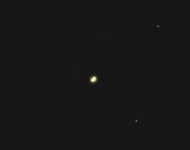
Beta Monoceri - unresolved in small and cheap scopes [1]

Beta Monoceri - a larger, quality scope resolves 3 stars [2,3]
Comets and Asteroids
Comets are small icy objects from outer solar system, which from time to time approach close enough to the Sun and become visible. At the beginning we can only see their coma (nebulous envelope) and a small bright "star" inside (nucleus). As comets drift closer, they become bigger, brighter and can develop an impressive tail of dust and gas.
Asteroids are rocky objects in inner solar system, and through a telescope the biggest of them appear as simple stars. What makes them interesting is their movement relative to background stars, which can be noticed over a period of hours:
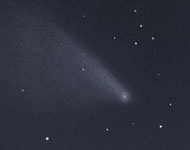
Panstarrs comet at low power with a clearly visible tail [2,3]
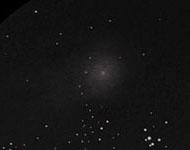
Garradd comet at higher power, with visible coma & nucleus [3]
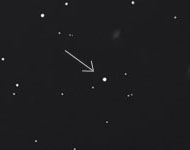 Irene asteroid, as it passes near a very faint galaxy [2,3]
Irene asteroid, as it passes near a very faint galaxy [2,3]The Sun
The Sun is a special subject - it must be observed with a full aperture filter. There are 2 general types of them. One is the narrowband filter (usually an H-alpha), which is an expensive device (starting from 600-1000) and it is often mounted on a dedicated solar telescope - see Coronado, Lunt or Daystar Quark products for examples. The other type is so called "daylight" filter - it can be mounted on any telescope, and can be quite cheap. The following images represent how our sun (and its sunspots) may look like through a simple daylight filter mounted on a cheap, small telescope (left) and a more quality instrument (right). Note that in this case it is often better to have a smaller aperture but higher optical quality (i.e. a quality 80mm ED doublet refractor). This is because during the daytime - atmospheric turbulence doesn't allow a larger telescope to fully utilize its resolving power. See this article for an overview of solar observing methods.
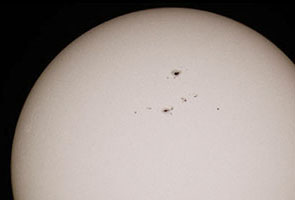
Sun through a small, cheap telescope [1]
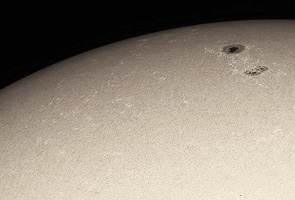
Sun through a higher quality telescope [2]
Other Objects
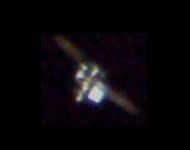
International Space Station through a quality telescope
There are several more "exotic" categories of objects you can observe as you become more experienced. Variable stars, for example, are stars which change their brightness over a period of months (days for some). Observing them and reporting the data via organization such as the AAVSO allows amateur astronomers to make their small scientific contribution. Novae and supernovae are violent explosions of distant stars, which occur from time to time, and can also be visible with an amateur telescope. Occultations of stars by our Moon (or by asteroids) are very fast events and can only be observed at very specific locations on Earth. Timing and reporting these events improves scientific data for these asteroids, and allows scientists to pinpoint the exact position of occulted star. Earth orbiting satellites can also be observed using amateur telescopes. The International Space Station, which is the largest of them, may even show glimpses of details (such as solar panels) during its closest approaches.

